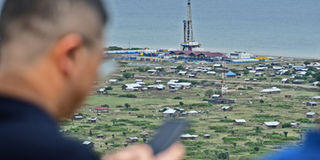Prime
CNOOC pledges to beat 2025/26 target of first oil

Kingfisher Oil Field at Buhuka, in Kyangwali Sub-county, Kikuube District, that is operated by CNOOC Uganda Limited. PHOTO | ABUBAKER LUBOWA.
What you need to know:
- The government has maintained there will be no more wait beyond 2025 or early 2026.
At the feet of the winding ranges of the Great Rift Valley, overlooking the lucid waters of the Albert in mid-Western Uganda lies the Kingfisher Development Area, one of Uganda’s oil fields.
From a vantage point, scattered settlements in the company of construction sites and imposing machinery line the peninsular that hosts the Kingfisher oil field. It is a beehive of activity here. The drilling rig, whose launch President Museveni termed a milestone, hasn’t rested since it was installed in January last year. It runs 24 hours to open the way for the crude to leave the reservoirs deep below the surface.
This is all in an attempt to align with Uganda’s plans to have her first oil flow out in late 2025, possibly stretching into early 2026, nearly two decades since the discovery of commercially viable deposits in 2006.
CNOOC Uganda Limited, the Chinese oil company that operates the Kingfisher field at Buhuka, in Kyangwali Sub-county, Kikuube District, says they are on track to deliver.
“We are on course to ensure that the first oil comes out of the ground and we are working to ensure that we attain first oil as promised,” Ms Amina Bukenya, the acting head of Corporate Affairs at CNOOC during a visit to the fields on Tuesday.
“Perhaps Uganda’s first barrel of oil will come from here,” Mr Fan Xuecheng, the Minister Counsellor of the Chinese Embassy, said.
The discovery of oil in the region brought high hopes and expectations among the locals, and leaders alike, with anticipated development and improvement of livelihoods from the so-called black gold.
The government has maintained there will be no more wait beyond 2025. President Museveni has previously linked the delay in exploiting the resource to the absence of local expertise, and infrastructure, and the need to develop a thorough legal regime to guide the sector.
An estimated 6.5 billion barrels of oil reserves, with at least 1.4m recoverable lie buried in the Albertine Graben. Two project areas, including the Kingfisher, are so far under development, with exploration and licensing for others ongoing.
The second, Tilenga, located north of Lake Albert along the River Nile, is operated by TotalEnergies.
The Kingfisher oil field is about 15km long, 3km wide and 2km below Lake Albert with an estimated 560 million barrels, 190 million of which are recoverable over the next 25 years.
Ms Bukenya revealed the company has so far invested $3.5b to put up the necessary infrastructure and equipment.
Its development is planned to be undertaken through the onshore drilling of 31 wells on four well pads.
So far, seven wells have been drilled, the deepest at 3,700 meters. At peak production, the field will put out 40,000 barrels per day.
Ms Vivian Maria, a well control engineer, said: “Currently, we are drilling four wells at pad three. Last year we had three wells on pad 2. The wells are drilled vertically and then deviated to the reservoirs, drilling happens 24/7. We are drilling development wells; that are going to produce the oil.”
The rig was manufactured and hauled in from China, adopted to emit minimal noise to limit inconvenience to local communities.
The crude will be pumped to the Central Processing Facility, currently at the foundation stage, from where the cleaned oil will through a 46km feeder pipeline join the EACOP. Construction of a $3.5 billion pipeline set to carry crude oil from the country to international markets is taking shape
“The well pads are up and running, you have seen the CPF and the tank foundations. The feeder pipeline, currently they are doing the excavations and the trenching. The welding [of pipes] was done months ago. The progress is quite good,” Mr Zakaliya Lubega from the corporate affairs department said.
Mr Liu Xiangdong, the president of CNOOC Uganda Limited, said the company, in all its works, remains committed to delivering on the theme ‘Energy for a Better Future’.
He highlighted, among others, adherence to international standards, local content promotion and environmental protection.
According to Mr Lubega, the company has undertaken different approaches to protect the environment and co-exist with the local communities.
“Production will play a critical role in driving the national GDP, about 30 percent contribution…CNOOCs investment is also key in development of associated sectors like transport and logistics,” he said “We are focused on building a high quality project and having Ugandans participating in these projects so that when other resources are discovered, the pool of talent being developed will be a pool of resources to support this industry,” he added
The company was in October last year granted a license to produce LPG gas, which they say will be key in both the improvement of livelihoods and reducing the environment footprint.
strong ties
Mr Xuecheng, citing the example of CNOOC’s investments, re-echoed China’s commitment to mutual cooperation with Uganda, both at the government level and for private companies.
“Based on adhering to the national standards and applied industrial practices, CNOOC put local content in a key position…employing more than 3,500 local workers. As construction continues, it is estimated that approximately 160,000 new jobs will be created,” he said.
The diplomat also intimated that trade volumes between the two countries continue to grow, standing at $1.3b, with Uganda exporting goods worth$70m at the end of 2023.
“China –Uganda bilateral relations are at their best in history, political mutual trust has been continuously enhanced. Pragmatic cooperation has yielded fruitful results,” he said.
He made the remarks during an art competition organised by CNOOC at Buhuka, where 30 students from the districts of Hoima and Kikuube participated.




